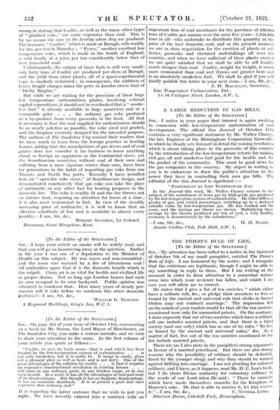" THE SMOKELESS CITY."
[To the Editor of the SPECTATOR.] Sin,—The authors of this interesting and important book, to which your reviewer directs attention in last week's Spectator, lay very proper emphasis on the importance of eliminating smoke from the domestic fire, pointing out that the first step on the road to success is to realize that the house chimney is a much more dangerous enemy than the factory chimney. They go on to state :-
"There is only one way in which a complete solution of the domestic smoke problem might be attained in reasonable time, by the discovery of a smokeless solid fuel to replace coal. . . . If such a fuel that would burn cheerfully and well, and would be no more expensive than coal, were available in adequate quantity and at a reasonable price, it would clearly be possible—it would, in fact, be the obvious duty of Parliament—in the general interest to prohibit the burning of raw coal in houses."
I venture to submit, however, that your contributor is
wrong in stating that Coalite, as well as the many other types of " glorified coke," are more expensive than coal. This is by no means the case in the locality where they are produced. For instance, " Coalite," which is made at Barugh, sells readily for 35s. per ton in Barnsley ; " Pyrex," another excellent low temperature coke, which is made in the South of England, is sold locally at a price per ton considerably below that of best household coal.
Unfortunately, the output of these fuels is still very small ; only forty tons of Coalite are produced per diem at Barugh, and the yield from other plants, all of a quasi-experimental type, is similarly restricted ; in consequence, the addition of heavy freight charges raises the price in London above that of " Derby Brights."
But while we are waiting for the provision of these huge low temperature carbonization plants, involving colossal capital expenditure, it should not be overlooked that a" smoke- less fuel " is already available in large quantities and at a reasonable price . . . the ordinary gas coke produced as a by-product from every gasworks in the land. All that is necessary is that the coal supplied for carbonization should be as nearly ash-free as possible, the coke sized and graded, and the fireplace correctly designed for the intended purpose. The authors of The Smokeless City remind their readers that we have much to learn from the foreign practice in heating houses, adding that the manufacturer of gas stoves and of coal grates does not consider it his business to know anything about so foreign an apparatus as the Continental stove, yet the Scandinavian countries, without coal of their own and suffering from a more rigorous winter than ours, have been for generations in the habit of importing gas coke from our Thames and North Sea ports. Recently I have installed here an " open-fire coke stove," of Scandinavian design, and demonstrated conclusively that gas coke can take the place of anthracite or any other fuel for heating purposes in the domestic fire. The coke is readily lit and the fire throws out an intense heat, requiring no attention for hours at a time ; it is also most economical in fuel. In view of the steadily increasing price of anthracite, it is well to know that an effective substitute at low cost is available in almost every locality.—I am, Sir, &c.,



































































 Previous page
Previous page